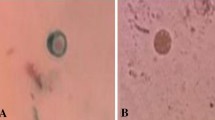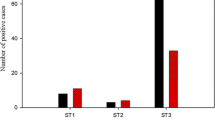Abstract
Blastocystis sp. is more prevalent in mentally-retarded individuals, immunocompromised patients, and organ recipients. There are no inclusive studies in Iran evaluating the prevalence and molecular identification of Blastocystis sp. infection in schizophrenic patients. This study aimed to determine prevalence and subtype distribution of Blastocystis sp. in schizophrenic patients in Tehran province, Iran. This cross-sectional study was performed on 58 stool samples of schizophrenic male patients in Tehran province, Iran, using the sequence-tagged site (STS) and ST-specific primers. Overall, 58 stool samples were collected from hospitalized male patients with schizophrenia in Tehran province. After conventional PCR, positive samples were probed by ST-specific and STS primers. Following molecular evaluation, 32 samples (55.2%) were positive for Blastocystis sp. Which, 28 (87.5%) cases were ST3, 3 (9.4%) cases were found to be ST9, and one case (3.1%) was ST1.This study was the first report of the ST9 of Blastocystis in Iran. Blastocystis infection was more prevalent in asymptomatic patients (55.6%) compared with symptomatic patients (55%). There was a significant association between the duration of hospitalization and Blastocystis infection rate (0.002). The results of the present study represented a high prevalence and significance of Blastocystis sp. infection in schizophrenic patients. Patients with schizophrenia are unable to attend to their own care. Also, schizophrenic patients have a lack of perception that can result in poor hygiene, which needs more care, accuracy, prevention, and control.

Similar content being viewed by others
References
Silberman JD, Sogin ML, Leipe DD, Clark CG. Human parasite finds taxonomic home. Nature. 1996;380(6573):398.
Alfellani MA, Taner-Mulla D, Jacob AS, Imeede CA, Yoshikawa H, Stensvold CR, et al. Genetic diversity of Blastocystis in livestock and zoo animals. Protist. 2013;164(4):497–509.
Suresh K, Smith H, Tan T. Viable Blastocystis cysts in Scottish and Malaysian sewage samples. Appl Environ Microbiol. 2005;71(9):5619–20.
Alfellani MA, Stensvold CR, Vidal-Lapiedra A, Onuoha ESU, Fagbenro-Beyioku AF, Clark CG. Variable geographic distribution of Blastocystis subtypes and its potential implications. Acta Trop. 2013;126(1):11–8.
Roberts T, Barratt J, Harkness J, Ellis J, Stark D. Comparison of microscopy, culture, and conventional polymerase chain reaction for detection of Blastocystis sp. in clinical stool samples. Am J Trop Med Hyg. 2011;84(2):308–12.
Li L-H, Zhou X-N, Du Z-W, Wang X-Z, Wang L-B, Jiang J-Y, et al. Molecular epidemiology of human Blastocystis in a village in Yunnan province, China. Parasitol Int. 2007;56(4):281–6.
Asghari A, Zare M, Hatam G, et al. Molecular identification and subtypes distribution of Blastocystis sp. isolated from children and adolescent with cancer in Iran: evaluation of possible risk factors and clinical features. Acta Parasitol. 2020. https://doi.org/10.2478/s11686-020-00186-2.
Bednarska M, Jankowska I, Pawelas A, Piwczyńska K, Bajer A, Wolska-Kuśnierz B, et al. Prevalence of Cryptosporidium, Blastocystis, and other opportunistic infections in patients with primary and acquired immunodeficiency. Parasitol Res. 2018;117(9):2869–79.
Rao K, Sekar U, Iraivan KT, Abraham G, Soundararajan P. Blastocystis hominis—an emerging cause of diarrhoea in renal transplant recipients. J Assoc Physicians India. 2003;51(1):719–21.
Mohammadi-Meskin V, Hamedi Y, Heydari-Hengami M, Eftekhar E, Shamseddin J, Sharifi-Sarasiabi K. Intestinal parasitic infections in mental retardation Center of Bandar Abbas, southern Iran. Iran J Parasitol. 2019;14(2):318–25.
Shehata AI, Hassanein F. Intestinal parasitic infections among mentally handicapped individuals in Alexandria, Egypt. Ann Parasitol. 2015;61(4).
Stensvold CR, Suresh GK, Tan KS, Thompson RA, Traub RJ, Viscogliosi E, et al. Terminology for Blastocystis subtypes–a consensus. Trends Parasitol. 2007;23(3):93–6.
Parkar U, Traub RJ, Vitali S, Elliot A, Levecke B, Robertson I, et al. Molecular characterization of Blastocystis isolates from zoo animals and their animal-keepers. Vet Parasitol. 2010;169(1):8–17.
Clark CG, van der Giezen M, Alfellani MA, Stensvold CR. Recent developments in Blastocystis research. Adv Parasitol. 2013;82(1):32.
Özyurt M, Kurt Ö, Mølbak K, Nielsen HV, Haznedaroglu T, Stensvold CR. Molecular epidemiology of Blastocystis infections in Turkey. Parasitol Int. 2008;57(3):300–6.
Yoshikawa H, Iwamasa A. Human Blastocystis subtyping with subtype-specific primers developed from unique sequences of the SSU rRNA gene. Parasitol Int. 2016;65(6):785–91.
Asghari A, Sadraei J, Pirestani M, Mohammadpour I. First molecular identification and subtype distribution of Blastocystis sp. isolated from hooded crows (Corvus cornix) and pigeons (Columba livia) in Tehran Province, Iran. Comp Immunol Microbiol Infect Dis. 2019;62:25–30.
Stensvold CR, Arendrup MC, Jespersgaard C, Mølbak K, Nielsen HV. Detecting Blastocystis using parasitologic and DNA-based methods: a comparative study. Diagn Microbiol Infect Dis. 2007;59(3):303–7.
Stensvold CR. Comparison of sequencing (barcode region) and STS PCR for Blastocystis subtyping. J Clin Microbiol. 2012;02541–12.
Williamson P. Mind, brain, and schizophrenia. Oxford: University press; 2006.
Khademvatan S, Khajeddin N, Izadi S, Yousefi E. Investigation of anti-Toxocara and anti-toxoplasma antibodies in patients with schizophrenia disorder. Schizophr Res Treat. 2014;2014:1–7.
Arias I, Sorlozano A, Villegas E, de Dios LJ, McKenney K, Cervilla J, et al. Infectious agents associated with schizophrenia: a meta-analysis. Schizophr Res. 2012;136(1–3):128–36.
Fuglewicz AJ, Piotrowski P, Stodolak A. Relationship between toxoplasmosis and schizophrenia: a review. Adv Clin Exp Med. 2017 Sep 1;26(6):1033–8.
Kaplan M, Kalkan A, Kuk S, Demirdag K, Ozden M, Kilic SS. Toxocara seroprevalence in schizophrenic patients in Turkey. Yonsei Med J. 2008;49(2):224–9.
Pınar A, Akyön Y, Alp A, Ergüven S. Adaptation of a sensitive DNA extraction method for detection of Entamoeba histolytica by real-time polymerase chain reaction. Mikrobiyol Bul. 2010;44(3):453–9.
Stensvold R, Brillowska-Dabrowska A, Nielsen HV, Arendrup MC. Detection of Blastocystis hominis in unpreserved stool specimens by using polymerase chain reaction. J Parasitol. 2006;92(5):1081–7.
Yoshikawa H, Wu Z, Kimata I, Iseki M, Ali IKM, Hossain MB, et al. Polymerase chain reaction-based genotype classification among human Blastocystis hominis populations isolated from different countries. Parasitol Res. 2004;92(1):22–9.
Scanlan PD, Stensvold CR, Cotter PD. Development and application of a Blastocystis subtype-specific PCR assay reveals that mixed-subtype infections are common in a healthy human population. Appl Environ Microbiol. 2015;81(12):4071–6.
Hall TA. BioEdit: a user-friendly biological sequence alignment editor and analysis program for Windows 95/98/NT. InNucleic acids symposium series 1999 Jan 1 (Vol. 41, No. 41, pp. 95–98). London: Information Retrieval Ltd. c1979–c2000.
Camacho C, Coulouris G, Avagyan V, Ma N, Papadopoulos J, Bealer K, et al. BLAST+: architecture and applications. BMC bioinformatics. 2009;10(1):421.
Kumar S, Stecher G, Li M, Knyaz C, Tamura K. MEGA X: molecular evolutionary genetics analysis across computing platforms. Mol Biol Evol. 2018;35(6):1547–9.
Messias EL, Chen C-Y, Eaton WW. Epidemiology of schizophrenia: review of findings and myths. Psychiatr Clin N Am. 2007;30(3):323–38.
Santín M, Gómez-Muñoz MT, Solano-Aguilar G, Fayer R. Development of a new PCR protocol to detect and subtype Blastocystis spp. from humans and animals. Parasitol Res. 2011;109(1):205–12.
Tungtrongchitr A, Manatsathit S, Kositchaiwat C, Ongrotchanakun J, Munkong N, Chinabutr P, et al. Blastocystis hominis infection in irritable bowel syndrome patients. 2004.
Moosavi A, Haghighi A, Mojarad EN, Zayeri F, Alebouyeh M, Khazan H, et al. Genetic variability of Blastocystis sp. isolated from symptomatic and asymptomatic individuals in Iran. Parasitol Res. 2012;111(6):2311–5.
Parkar U, Traub R, Kumar S, Mungthin M, Vitali S, Leelayoova S, et al. Direct characterization of Blastocystis from faeces by PCR and evidence of zoonotic potential. Parasitology. 2007;134(3):359–67.
Stensvold CR, Alfellani M, Clark CG. Levels of genetic diversity vary dramatically between Blastocystis subtypes. Infect Genet Evol. 2012;12(2):263–73.
Jantermtor S, Pinlaor P, Sawadpanich K, Pinlaor S, Sangka A, Wilailuckana C, et al. Subtype identification of Blastocystis spp. isolated from patients in a major hospital in northeastern Thailand. Parasitol Res. 2013;112(4):1781–6.
Motazedian H, Ghasemi H, Sadjjadi S. Genomic diversity of Blastocystis hominis from patients in southern Iran. Ann Trop Med Parasitol. 2008;102(1):85–8.
Badparva E, Sadraee J, Kheirandish F, Frouzandeh M. Genetic diversity of human blastocystis isolates in Khorramabad, Central Iran. Iran J Parasitol. 2014;9(1):44–9.
Khademvatan S, Masjedizadeh R, Yousefi-Razin E, Mahbodfar H, Rahim F, Yousefi E, et al. PCR-based molecular characterization of Blastocystis hominis subtypes in southwest of Iran. J Infect Public Health. 2017.
Stensvold C, Lewis H, Hammerum AM, Porsbo LJ, Nielsen S, Olsen K, et al. Blastocystis: unravelling potential risk factors and clinical significance of a common but neglected parasite. Epidemiol Infect. 2009;137(11):1655–63.
Dullaert-de Boer M, Schuurs TA, Vermeer M, Ruijs GJ, van der Zanden AG, Weel JF, et al. Distribution and relevance of Dientamoeba fragilis and Blastocystis species in gastroenteritis: results from a case-control study. Eur J Clin Microbiol Infect Dis. 2020 Jan 1;39(1):197–203.
Acknowledgments
The authors thank the Vice Chancellor for Research of Tarbiat Modares University for support of this study.
Author information
Authors and Affiliations
Corresponding author
Ethics declarations
Conflict of Interest
The authors declare that they have no conflict of interest.
Ethical Approval
All stages of the present study were confirmed by the Ethics Committee of Tarbiat Modares University, Tehran, Iran.
Informed Consent
Informed consent was obtained from all individual participants included in the study.
Additional information
Publisher’s Note
Springer Nature remains neutral with regard to jurisdictional claims in published maps and institutional affiliations.
This article is part of the Topical Collection on Medicine
Rights and permissions
About this article
Cite this article
Sheikh, S., Asghari, A., Sadraei, J. et al. Blastocystis sp. Subtype 9: as the First Reported Subtype in Patients with Schizophrenia in Iran. SN Compr. Clin. Med. 2, 633–639 (2020). https://doi.org/10.1007/s42399-020-00285-1
Accepted:
Published:
Issue Date:
DOI: https://doi.org/10.1007/s42399-020-00285-1




